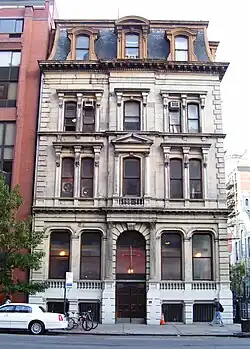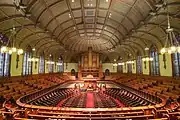Carl Pfeiffer | |
|---|---|
| Born | 1834[lower-alpha 1] |
| Died | April 27, 1888 |
| Nationality | German |
| Occupation | Architect |
.jpg.webp)
Carl Pfeiffer (1834-1888) was a German American architect practicing in New York City.
Life and career
Carl Pfeiffer was born in 1834 in Brunswick, Germany,[lower-alpha 1] and came to the United States as a teenager in 1850. He was trained in architecture and engineering in Ohio and elsewhere in the midwest before coming east to New York City c. 1860, where he worked as a draftsman for four additional years.[lower-alpha 2][2] At an unknown date he also worked with the Philadelphia architect Samuel Sloan, who in 1868 called him a "friend and former pupil."[3] In 1864 he established an office of his own in New York, and was in continuous practice until his death in 1888.[2] He was particularly known for his expertise in ventilation systems, and designed many hospitals and churches.[1]
Pfeiffer joined the American Institute of Architects in 1867, and was elected a Fellow in 1872.[4] For two years he was secretary of the organization.[5] Following his death, Pfeiffer's practice was purchased by architect Peter J. Lauritzen, then of Brooklyn. Lauritzen's works include the Offerman Building in Brooklyn.[6]
Personal life
Pfeiffer was married to Elizabeth Dayton in 1871. She was the daughter of Aaron Ogden Dayton, the long-time Fourth Auditor of the United States Treasury.[7] They had two children, a son and a daughter. For the last few years of his life Pfeiffer was in poor health, and about a month prior to his death traveled south to Asheville, North Carolina, in search of rest. On his return north he stopped at the home of relatives in Washington, D.C., where he died April 27, 1888.[8] His wife died August 21, 1913, in New York.[9]
Legacy
Two of Pfeiffer's works have been designated New York City Landmarks, one of which has also been listed on the United States National Register of Historic Places.
Architectural works
- 140 West Broadway building, New York City (1866)[10]
- Church of the Messiah, 10 Park Ave, New York City (1866–68, demolished 1931)[11]
- German Hospital, Park Ave and E 77th St, New York City (1867, demolished)[12]
- Metropolitan Savings Bank Building, 9 E 7th St, New York City (1867, NYCL 1969, NRHP 1979)[3][13]
- Roosevelt Hospital, 1000 Tenth Ave, New York City (1869–71, demolished)[14]
- Germania Fire Insurance Company Bowery Building, 357 Bowery, New York City (1870, NYCL 2010)[15]
- "Oak Terrace" for Valentine G. Hall Jr., 794 Woods Rd, Clermont, New York (1872)[16]
- Second Reformed (Hope) Church,[lower-alpha 3] 77 W 11th St, Holland, Michigan (1872–74, demolished 1981)[17][18]
- Fifth Avenue Presbyterian Church, 7 W 55th St, New York City (1873–75)[11]
- St. Omer Hotel, 724 (formerly 384) Sixth Ave, New York City (1873, demolished)[19]
- Middletown State Hospital, 45 Ashley Ave, Middletown, New York (1874, demolished)[8]
- New Jersey Building, Centennial Exposition, Philadelphia, Pennsylvania (1876, temporary building)[20]
- The Berkshire, 21 E 52nd St, New York City (1881, demolished)[21]
- House for Earl P. Mason, 23 Charlesfield St, Providence, Rhode Island (1882, demolished 1952)[22]
- House for Annie Dayton and Mary Dayton,[lower-alpha 4] 1917 N St NW, Washington, DC (1883, demolished)[23]
- Moses Taylor Hospital, 700 Quincy Ave, Scranton, Pennsylvania (1883, partially extant)[24]
- House for Horatio N. Campbell Jr., 50 Narragansett Bay Ave, Warwick, Rhode Island (1884)[25][26]
- All Saints Memorial Episcopal Church (former), 11 Aspetuck Ave, New Milford, Connecticut (1885–88)[27]
Gallery of architectural works
_PARK_AVENUE_AND_EAST_34TH_STREET.jpg.webp) Church of the Messiah, New York City, 1866-68.
Church of the Messiah, New York City, 1866-68._pg482_GERMAN_HOSPITAL%252C_PARK_AVE._AND_EAST_77TH_STREET.jpg.webp) German Hospital, New York City, 1867.
German Hospital, New York City, 1867.
 Germania Fire Insurance Company Bowery Building, New York City, 1870.
Germania Fire Insurance Company Bowery Building, New York City, 1870..jpg.webp) Fifth Avenue Presbyterian Church, New York City, 1873-75.
Fifth Avenue Presbyterian Church, New York City, 1873-75. Interior view of the Fifth Avenue Presbyterian Church, New York City, 1873-75.
Interior view of the Fifth Avenue Presbyterian Church, New York City, 1873-75..jpg.webp) New Jersey Building, Centennial Exposition, Philadelphia, Pennsylvania, 1876.
New Jersey Building, Centennial Exposition, Philadelphia, Pennsylvania, 1876.
Bibliography
- Carl Pfeiffer, American Mansions and Cottages (Boston: Ticknor, 1889)[lower-alpha 5]
See also
Notes
- 1 2 Other years are given by different sources, including 1836 and 1838.
- ↑ Some sources, including his obituary in the American Architect and Building News, instead indicate that he received a thorough education as an engineer in Germany and came to the United States in his twenties.[1]
- ↑ This building was executed by architect William G. Robinson of Grand Rapids. The tower has been incorporated into the new building on the site.
- ↑ The home of Pfeiffer's sisters-in-law, where he died in 1888.
- ↑ Published posthumously.
References
- 1 2 "Death of Carl Pfeiffer, Architect" in American Architect and Building News 23, no. 648 (May 26, 1888): 241.
- 1 2 Joseph Thomas, "Pfeiffer, Carl" in Universal Pronouncing Dictionary of Biography and Mythology 2 (Philadelphia: J. B. Lippincott Company, 1905) 711.
- 1 2 "Metropolitan Savings Bank" in Sloan's Architectural Review and Builders Journal 1 (November, 1868): 296-299.
- ↑ Carl Pfeiffer, AIA Historical Directory of American Architects.
- ↑ "Carl Pfeiffer" in Engineering and Building Record 17, no. 23 (May 5, 1888): 323.
- ↑ "Peter J. Lauritzen" in The Eagle and Brooklyn 3 (Brooklyn: Brooklyn Daily Eagle, 1893): 893.
- ↑ "Married" in New York Times, April 19, 1871, 5.
- 1 2 "Carl Pfeiffer's Death" in New York Times, April 29, 1888, 10.
- ↑ "Died" in New York Times, August 23, 1913, 7.
- ↑ Tribeca West Historic District LPC Designation Report (1991)
- 1 2 David W. Dunlap, From Abyssinian to Zion: A Guide to Manhattan's Houses of Worship (New York: Columbia University Press, 2004)
- ↑ "The New German Hospital" in Harper's Weekly 11, no. 569 (November 23, 1867): 748.
- ↑ Metropolitan Savings Bank NRHP Registration Form (1979)
- ↑ North American Journal of Homeopathy 18, no. 70 (November, 1869): 285.
- ↑ Germania Fire Insurance Company Bowery Building LPC Designation Report (2010)
- ↑ Shannon Butler, Roosevelt Homes of the Hudson Valley (Charleston: History Press, 2020)
- ↑ History of Ottawa County, Michigan (Chicago: H. R. Page & Company, 1882)
- ↑ About Hope Church, Hope Church.
- ↑ Real Estate Record and Builders Guide 12, no. 279 (July 19, 1873): 342.
- ↑ "The Illustrations" in American Architect and Building News 1 (April 1, 1876): 109.
- ↑ "A Modern Apartment House" in Carpentry and Building 3, no. 9 (September, 1881): 165.
- ↑ John Hutchins Cady, The Civic and Architectural Development of Providence 1636-1950 (Providence: The Book Shop, 1957)
- ↑ American Architect and Building News 13, no. 374 (February 24, 1883): 96.
- ↑ Manufacturer and Builder 15, no. 5 (May, 1883): 113.
- ↑ American Architect and Building News 15, no. 419 (January 5, 1884): 11.
- ↑ Building 2, no. 7 (April, 1884)
- ↑ "All Saints' Memorial Church, New Milford, Conn." in Churchman 58, no. 16 (October 20, 1888): 497.